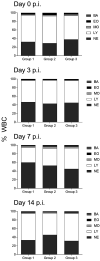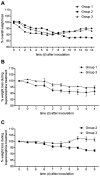Effects of Buprenorphine Treatment on Influenza Pathogenesis in the Ferret (Mustela putorius furo)
- PMID: 35256041
- PMCID: PMC8915411
- DOI: 10.30802/AALAS-CM-21-000087
Effects of Buprenorphine Treatment on Influenza Pathogenesis in the Ferret (Mustela putorius furo)
Abstract
Ferrets are the gold-standard model for influenza A virus (IAV) research due to their natural susceptibility to human and zoonotic IAV, comparable respiratory anatomy and physiology to humans, and development of clinical signs similar to those seen in infected people. Because the presence and progression of clinical signs can be useful in infectious disease research, uncertainty in how analgesics alter research outcomes or compromise characteristics of disease progression have outweighed the concern regarding animal discomfort from these symptoms. Nonetheless, the principles of animal research require consideration of refinements for this important model for IAV research. Opioids offer a possible refinement option that would not directly affect the inflammatory cascade involved in IAV infection. Mirroring pathogenicity studies that use ferrets, 12 ferrets were inoculated intranasally with the A(H3N2) IAV A/Panama/2007/1999 and divided into 3 treatment groups ( n = 4 each), of which 2 groups received buprenorphine treatments on different schedules and the third received a saline control. The duration and location of viral replication, lymphohematopoietic changes, and clinical signs were comparable across all groups at all time points. High quantities of infectious virus in nasal wash specimens were detected in ferrets from all groups through day 5 after inoculation, and peak viral titers from the upper respiratory tract did not differ between ferrets receiving buprenorphine treatments on either schedule. Compared with the saline group, ferrets receiving buprenorphine exhibited transient weight loss and pyrexia, but all groups ultimately achieved similar peaks in both of these measurements. Collectively, these findings support the continued evaluation of buprenorphine as a refinement for IAV-challenged ferrets.
Figures



References
-
- Balls M, Straughan DW. 1996. The three Rs of Russell and Burch and the testing of biological products. Dev Biol Stand 86:11–18. - PubMed
MeSH terms
Substances
LinkOut - more resources
Full Text Sources
Medical

